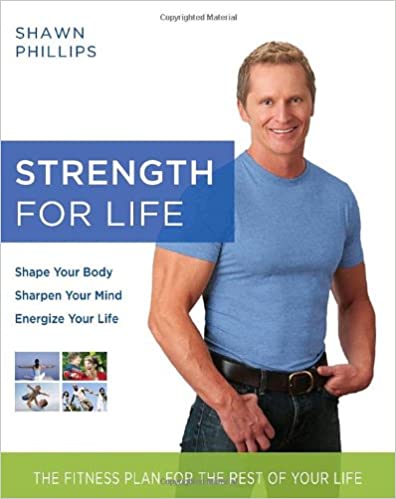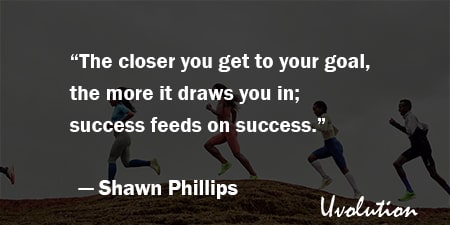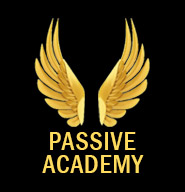Strength for Life by Shawn Phillips
The Book in 1 Sentences
Strength for Life: The Fitness Plan for the Rest of Your Life
“Your body, the only one you will ever have, is the foundation of your life. And it’s either an anchor limiting your freedom and potential or a source of radiant energy, vitality and joy, elevating your life and the lives of those around you.
It’s your choice… will yours be a source of strength, from which you will impact the world, or an obstacle, preventing you from your dreams and desires? … As my friend, NFL Hall of Fame quarterback John Elway is fond of saying, ’If you’re going to bother setting a goal, aim high!’ … My advice to you, aim high; aim for strength.” ~ Shawn Phillips
15 BIG Ideas
1. Transformation = Significant and Lasting Change
2. Strength = Presence of Abundant Energy
5. Do You Think You’re Too Old?
6. The Mastery of Your Focus (+ Meditation)
7. FIT (Focused Intensity Training)
9. Strength Training Improves Your Brain!
10. Strength Training Makes You Smaller!
12. The Clarity of Your Vision
Strength for Life Book Summary
1. Transformation = Significant and Lasting Change
“It’s important to note here, there is a difference between change and transformation. Where change is change, I define Transformation as ‘significant and lasting change.’ It’s change that doesn’t snap back to the way it was before.”
And remember that “Bruce Lee said it well in these words: ‘Knowing is not enough, you must apply; willing is not enough, you must do.’ You can count on me to reach in and help fire you up, to keep you moving and inspired for greatness, but ultimately it’s up to you.”
2. Strength = Presence of Abundant Energy
“Where health is no more than the absence of disease; Strength is the presence of abundant energy – a capacity and reserve to be a force in your world. It’s inclusive of health and at the same time so much more; it’s being healthy and flowing with energy, power and confidence.”
“Strength is the something extra; the mental, physical, emotional reserve – the fuel that makes for an extraordinary life. Where ‘health’ is like living paycheck to paycheck, strength is money in the bank – a reserve. Strength is true wealth.”
3. Overweight & Obesity
“The numbers are startling. According to the National Center for Health Statistics, about 30% of U.S. adults 20 and older are obese and 65 percent are either overweight or obese… One out of five kids ages 12 to 19 is now considered obese.”
And “64% of obese people don’t think they’re obese – ‘it’s the other guy or gal. Not me.’”
And do you know that “Recently we crossed a tipping point where, for the first time in recorded history, the youngest generation of children are now expected to live shorter lives than their parents, even though medical technology continues to advance and we know far more about the impact of poor diet and inactivity than ever before.”
4. Living in The Gap!
“Whether you face reality head on and make a life change, or deny your responsibility, you’ve made a choice. The way I see it you choose either a life of abundant strength and energy, or you’re living in the gap, far beneath the quality of life you could be enjoying.”
“Most people are settling for less than their potential, for less strength, energy and vitality than they both can have and deserve. To accept life anywhere below our fullest potential is to be living in the gap, blindly accepting ‘what is’ without ever deeply considering ‘what could be.’”
Shawn is talking about living in a gap between what you’re *capable* of doing/being and what you’re *actually* doing/being.
Try as hard as you can to close the gap to start living the life you deserve…
5. Do You Think You’re Too Old?
“You’re never too old to gain strength. The Noll Laboratory for Human Performance compared young men with men between ages 45 and 60 and found that percentage of body fat, along with aerobic capacity, was not related to age but rather to the amount of time spent training their body.
The Human Nutrition Center on Aging found muscle growth in people ranging from 60 to 96 years old was statistically equivalent to younger people doing the same amount of training with their bodies.”
Shawn continues: “As this research indicates, the symptoms of aging are less dependent on age and more related to lifestyle. Thus, a lifestyle that includes regularly engaging one’s body with strength training can make you strong now and keep you going strong for life.”
“The evidence is strong and science validates what millions of Transformation success stories have revealed: ‘typical signs of aging’ are more the result of how you live than how long you’ve lived.”
6. The Mastery of Your Focus (+ Meditation)
“Focus is the concentration of attention to the exclusion of all else. It means putting everything you have into what you’re doing at this very second—whether it’s on work, training, nutrition, a friend or loved one. When you’re focused, you’re not thinking about the past or future. Nothing else enters your mind.”
“Perhaps more than any other factor, it is the mastery of your focus—which precedes mastery of your energy—that separates the average performers from the peak performers in life.
The freedom to place your focused attention where you want it, when you want it, offers a competitive advantage in a world where the average attention span is measured in seconds, not minutes.
It’s precisely the skill that has so many high profile leaders adopting meditation practices. Steve Jobs of Apple, music icons Rick Rubin and Russell Simmons, Oprah, Bill Ford of Ford Motor Co., and the Clintons are a few of the prominent names that belong to the rapidly growing population of Americans—currently reported to be more than 20 million—who have embraced the practice of meditation.”
7. FIT (Focused Intensity Training)
“FIT blends an active meditation with strength training—strengthening your power to focus while strengthening your body.”
“FIT is at the heart of the training you will do in the Strength for Life program. Its aim is to develop not simply your physical strength but integral strength: the strength of body, mind, emotions, and more. Think of this new style as strength training from the inside out—integral strength training.”
8. Exercise Vs. Training
“For a clear example of the difference between exercise and training, consider the fact that athletes don’t go to ‘exercise camp,’ they go to training camp. Why? Because they are ‘in training;’ focused on achieving specific results, which fuels an intense drive and motivation.”
“Your ability to focus through strength training is a metaphor for the rest of your life. If you can’t focus in the gym, your results will be modest—not insignificant, but only a fraction of what you could achieve. The same is true with life. Through FIT, you can learn this focus in your training, and that will translate into all aspects of your life.”
9. Strength Training Improves Your Brain!
“Training stimulates endorphins, neurotransmitters, and neurotrophic growth factors your brain thrives on, making you feel good during and immediately following training.
Scientists are now discovering long-term positive effects of regular strength training: it makes your neurons more robust while improving blood flow, oxygen and nutrients to your brain.”
“Michael Craig Miller, M.D., editor in chief of the Harvard Mental Health Letter, summarizes what scientists have been uncovering for several decades, regular training ‘improves your mood, decreases anxiety, improves sleep and resilience in the face of stress and raises self-esteem.’
He adds that exercise itself makes for a ‘pretty good anti-depressant too, equal to drugs or psychotherapy in some studies.’”
Check out Spark book by John Ratey to learn more about how exercise improves brain functions and mood.
10. Strength Training Makes You Smaller!
For anyone concerned that strength training will make them “look big.”
Shawn says, “Here’s the irony: strength training actually makes you smaller. That’s because a pound of muscle is much smaller and takes up less space than a pound of fat.
A pound of fat is about the size of a cantaloupe. In contrast a pound of lean muscle is about the size of a baseball.
Using this analogy imagine how amazing you would look and feel if you swap 20 pounds of fat (think 20 cantaloupes) for five pounds of lean shape-defining muscle (think 5 baseballs).”
11. Base Camp & The 5 Rules
“Appropriately named after the camp where the essential and final preparations are made by those seeking to scale the world’s highest summit—that of Mt. Everest, Base Camp is a period of preparation.
It’s a time to rest, recover, rejuvenate, and recharge your body and mind. It’s not a time of more, but of less. It’s a time to relax the systems, not overwhelm with new demands.”
Shawn’s 5 Rules for his 12-days of Base Camp:
“1. Eat ‘Lean, Clean, and Green’;
2. Drink water in abundance each day;
3. Enjoy a minimum of 7 hours of restful sleep each night;
4. Flex your muscle of gratitude and positive focus each day;
5. Regroup with the Base Camp Training Plan.”
Shawn talks about water, and advises us: “Drink at least ten 8-ounce glasses of water daily to stay properly hydrated. For an athlete, a 1% drop in hydration can reduce performance output by as much as 20%.
For the average person dehydration increases the accumulation of toxins in the body, stunts metabolism, increases risk of cancer and accelerates the aging process. In a dehydrated state the mind and body do not operate at optimal levels.”
And he also talks about sleep: “In one study published in the ‘Journal of Sleep’ individuals who slept for only 4 hours produced cortisol levels on average 37 percent higher than those who got a full 8 hours of sleep.”
12. The Clarity of Your Vision
“Together, an inspiring vision and clear goals serve as a blueprint for your lasting success—your choice to live a strong life, however you define it. It’s the life you’re most drawn into, a brilliant future that pulls you forward each day with great force.”
“As you’ll come to know, the closer you get to your goal, the more it draws you in; success feeds on success. It’s like a gravitational pull. Once you get into a rhythm, it’s hard to stop. You achieve big visions by doing the little things every day and looking at them in a positive focus.”
13. Habits Vs. Rituals!
“People tend to talk in terms of ‘good habits’ and ‘bad habits,’ but I prefer to think in terms of rituals and habits. Think about it. Whenever you hear someone say, ‘She has a habit of –’ the thing that comes next is rarely positive.
The difference between rituals and habits is that you choose to do rituals; you have some degree of awareness and intention. People tend to admire your rituals.”
14. 12 Weeks of Transformation
“Your body is an amazingly adaptive machine. Ask it to be stronger and stronger you will be. Challenge it to go further and further you will go. Coax it to be more limber and more limber it will be.
Allow it to mold into the seat of a recliner and, you got it, a recliner seat it will become. Stretch it, push it, pull it; your body is like cellular Play-Doh waiting for you to be the sculptor.”
Shawn’s program is all about catalyzing your vision and goals into a guided 12 weeks of transformation. I highly recommend the book as a great tool to transform your life from inside out.
15. Start Right Now!
“How strong are you? How will you lift the world? How will you be a beacon of strength for others? These are the questions of utmost importance… Every one of us has a time limit to fulfill our destiny.
Don’t be one who waits for the final buzzer to start to really live. Yesterday is a memory and tomorrow is a dream. Today is the day to make your mark—to make a difference.”
That was my QUICK summary of the great book Strength for Life by Shawn Phillips. If you’re interested, get your copy. There is a HUGE amount of wisdom and life-changing ideas in this book, and we’ve only touched on a tiny bit of it.
Buy The Book: Strength for Life by Shawn Phillips

GET Blinkist 7 Days FREE Trial
3000+ Book Summaries
(Audio and Text)





